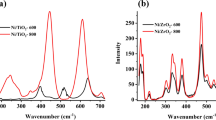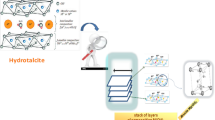Abstract
The commercial potential for a given catalytic process may be influenced by requirements on metal loading, in particular where noble metals are used. In an effort to substantially decrease the amount of catalyst material used for methane activation and catalytic partial oxidation (CPO), the effect of 0.005 wt% noble metal (Rh, Ru, Pd or Pt) on 0.5 wt% Ni/γ-Al2O 3 catalysts have been studied at temperatures below 1,173 K and 1 atm. The successful catalysts were activated directly by in situ reduction, without a calcination step, to promote formation of a highly dispersed (supported) metal phase from nitrate precursors. The obtained metal particles were not observable by XRD (size < 2–3 nm). This activation procedure had a decisive effect on catalyst activity, as compared to a catalyst which was calcined ex situ before in situ reduction. Adding a noble metal caused a significant drop in the ignition temperature during temperature programmed catalytic partial oxidation (TPCPO). The ignition temperature for partial oxidation coincides well with the temperature for methane dissociation, and is likely correlated to the reducibility of the noble metal oxide. Methane partial oxidation over 0.5 wt% Ni catalysts, both with and without promoter, yielded high selectivity to synthesis gas (>93%) and stable performance for continued operation, but synthesis gas production at temperatures below 1,073 K required a promoter when the catalyst was ignited by TPCPO. Ignition of the CPO reactions by introducing the feed at a high furnace temperature (1,073 K) also enabled formation of synthesis gas, but the reaction was then less stable than obtained with the TPCPO procedure. A dual bed concept attempted to beneficially use the activation and combustion properties of the noble metal followed by the reforming properties of Ni. However, it was concluded that co-impregnated catalysts yielded as high, or even higher conversion of methane and selectivity to synthesis gas.












Similar content being viewed by others
References
Liander H (1929) Trans Faraday Soc 25:462
Peña MA, Gómez JP, Fierro JLG (1996) Appl Catal A 144:7
Rostrup-Nielsen JR, Sehested J (2002) Adv Catal 47:65
Prettre M, Eichner C, Perrin M (1946) Trans Faraday Soc 42:335b
Vernon PDF, Green MLH, Cheetham AK, Ashcroft AT (1990) Catal Lett 6:181
Ashcroft AT, Cheetham AK, Foord JS, Green MLH, Grey CP, Murrell AJ, Vernon PDF (1990) Nature 344:319
Ashcroft AT, Cheetham AK, Green MLH, Vernon PDF (1991) Partial oxidation of methane to synthesis gas using carbon dioxide. Nature 352:225
Tsang SC, Claridge JB, Green MLH (1995) Catal Today 23:3
York APE, Xiao T, Green MLH (2003) Top Catal 22:345
Reyes SC, Sinfelt JH, Feeley JS (2003) Ind Eng Chem Res 42:1588
Enger BC, Lødeng R, Holmen A (2008) Appl Catal A 346:1
Ferreira-Aparicio P, Rodríguez-Ramos I, Guerrero-Ruiz A (1997) Appl Catal A 148:343
Choudhary VR, Rajput AM, Mamman AS (1998) J Catal 178:576
Jóźwiak WK, Nowosielska M, Rynkowski J (2005) Appl Catal A 280:233
Iglesia E (1997) Appl Catal A 161:59–78
Gadalla AM, Bower B (1988) Chem Eng Sci 43(11):3049
Zhang Y, Xiong G, Sheng S, Yang W (2000) Catal Today 63:517
Villacampa JI, Royo C, Romeo E, Montoya JA, Del Angel P, Monzón A (2003) Appl Catal A 252:363
Sahli N, Petit C, Roger AC, Kiennemann A, Libs S, Bettahar MM (2006) Catal Today 113: 187
Yan QG, Weng WZ, Wan HL, Toghiani H, Toghiani RK, Pittman Jr CU (2003) Appl Catal A 239:43
Wei J, Iglesia E (2004) J Catal 224:370
Bizzi M, Basini L, Saracco G, Specchia V (2002) Chem Eng J 90:97
Enger BC, Lødeng R, Holmen A (2008) Methane activation, H2 and CO formation on low-loading Ni catalysts, poster, 14th international congress on catalysis, Seoul, Korea
Choudhary TV, Goodman DW (2000) J Mol Catal A: Chem 163:9
Choudhary VR, Prabhakar B, Rajput AM (1995) J Catal 157:752
Nakagawa K, Ikenaga N, Teng Y, Kobayashi T, Suzuki T (1999) Appl Catal A 180:183
Basile F, Fornasari G, Trifirò F, Vaccari A (2001) Catal Today 64:21
Basile F, Fornasari G, Trifirò F, Vaccari A (2002) Catal Today 77:215
Li B, Kado S, Mukainakano Y, Nurunnabi M, Miyao T, Naito S, Kunimori K, Tomishige K (2006) Appl Catal A 304:62
Ji Y, Li W, Xu H, Chen Y (2001) Catal Lett 71:45
Dias JAC, Assaf JM (2004) J Power Sources 130:106
Enger BC, Lødeng R, Holmen A (2009) J Catal 262:188
Enger BC, Lødeng R, Holmen A (2009) Evaluation of reactor and catalyst performance in methane partial oxidation over modified nickel catalysts. Appl Catal A (Accepted)
Aartun I, Gjervan T, Venvik H, Görke O, Pfeifer P, Fathi M, Holmen A, Schubert K (2004) Chem Eng J 101:93
Silberova B, Venvik HJ, Holmen A (2005) Catal Today 99:69
Pawelec B, Damyanova S, Arishtirova K, Fiero JLG, Petrov L (2007) Appl Catal A 323:188
Hilmen AM, Schanke D, Holmen A (1996) Catal Lett 38:143
Hickman DA, Schmidt LD (1993) Science 259:343
Hickman DA, Schmidt LD (1993) AIChE J 39:1164
Rodriguez JA (1996) Surf Sci Rep 24:223
Veser G, Ziauddin M, Schmidt LD (1999) Catal Today 47:219
Acknowledgments
The financial supports of the Research Council of Norway, and StatoilHydro ASA through the RENERGI program, and the Norwegian University of Science and Technology (NTNU) are greatly acknowledged.
Author information
Authors and Affiliations
Corresponding author
Rights and permissions
About this article
Cite this article
Enger, B.C., Lødeng, R. & Holmen, A. Effects of Noble Metal Promoters on In Situ Reduced Low Loading Ni Catalysts for Methane Activation. Catal Lett 134, 13–23 (2010). https://doi.org/10.1007/s10562-009-0219-1
Received:
Accepted:
Published:
Issue Date:
DOI: https://doi.org/10.1007/s10562-009-0219-1




